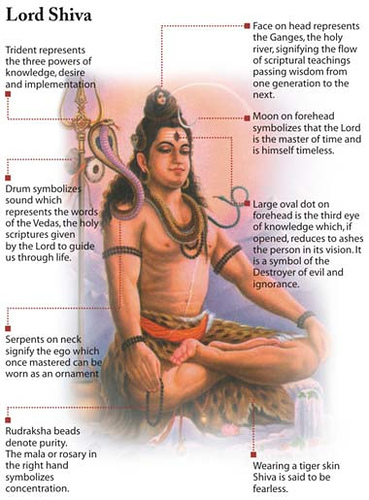Creation;
The divine essence is known as the brahman. In the beginning, the only object in the universe was the divine essence. There was nothing else. Itwas this brahman which divided itself into three different parts, Brahma,Vishnu and Shiva. Brahma became the creator, Vishnu the preserver and Shiva the destroyer.There was only water in the universe then. In the water, a gigantic egg
(anda) appeared. Brahma emerged from this egg. Inside the egg werealso all the worlds that would be created.During Brahma’s day , creation flourishes. But during Brahma’s night,there is destruction (pralaya). When Brahma merged out of the primordial egg, that constituted the original process of creation (sarga).But the following the process of destruction that takes place during Brahma’S night, there is also a periodical process of re-creation (pratisarga). Time is divided into four different eras - satya yuga, treta yuga, dvapara yuga and kali yuga. Satya yuga lasts for four thousand years of thegods, treta yuga for three thousand, dvapara yuga for two thousand and kali yuga for one thousand. A mahayuga is the period from the beginning of satya yuga to the end of kali yuga. It thus lasts for then thousand years of the gods. But in addition, there are intervenin gperiods (sandhyamsha) between satya yuga and treta yuga is seven hundred years, that between treta yuga and dvapara yuga five hundred years, that between dvapara yuga and kali yuga three hundred yearsand that between kali yuga and the new satya yuga five hundred years. This adds another two thousand years. Thus a mahayuga really lasts for twelve thousands years of the gods.The smallest unit of time is a nimesha. That is the length of time it takes to blink one’s eyes. Fifteen nimeshas constitute a kashtha, thirty kashthas are called a kala and thirty kalas make up one muhurta. There are fifteen muhurtas during the day and fifteen muhurtas during the night. Thirty muhurtas make up night and day, known as ahoratra. One year for humans is equivalent to one ahoratra for the gods. The six months during which the gods have their day is called uttarayana and the six months during which the gods have their night is called
dakshinayana. Three hundred and sixty human years are equivalent to one divine year. Thus, twelve thousand divine years are equivalent to 4,320,000 human years and this is the length of a mahayuga.
Satya yuga lasts for 1,440,000 human years; treta yuga or 1,080,000;
dvapara yuga for 720,000; and kali yuga for 360,000. This adds up to a
total of 3,600,000 human years. Once one adds 720,000 years for the
sandhyamshas, one obtains the figure of 4,320,000 human years in a
mahayuga.There are a little over seventy-one mahayugas in a manvantara.
Seventy-one mahayugas would add up to 296,720,000 human years.
There are actually 306,720,000 human years in a manvantara.
One thousand mahayugas make up one kalpa. There are thus
4,320,000,000 human years in a kalpa. Equivalently, fourteenmanvantaras constitute one kalpa. A kalpa corresponds to Brahma’s
adhoratra. One thousand kalpas are one year for Brahma and eight thousand such
years are one yuga for Brahma. One thousand of Brahma’s yugas are
equivalent to one of Vishnu’s days. Nine thousand of Vishnu’s days are
equivalent to merely one day for Shiva. (This is an attempt to establish
Shiva’s supremacy. In a Purana that glorifies Vishnu more, the relative
rankings of Shiva and Vishnu would be reversed.) At the end of one of Brahma’s days, the entire universe and all the
beings in it are destroyed Brahma, Vishnu and Shiva are not however
destroyed. There is darkness and water everywhere and Vishnu sleeps on this water. Since nara means water and ayana means resting -place,Vishnu is also known as Narayana.When the day dawns, Brahma begins creation afresh.
Brahma first created three sons through his mental powers. Their names were Sananda, Sanaka and Sanatan. (In other Puranas, a fourth son named Sanatakumara is mentioned.) These sons became sages and
performed intense meditation. Brahma also created another nine sons through his mental powers. Their names were Marichi, Bhrigu, Angira, Pulastya, Pulaha, Kratu, Daksha, Atri and Vashishtha.To ensure that creation progressed further, Brahma next divided his
body into two halves. The male half was known as Svayambhuva Manu and the female half was known as Shatarupa. These two married and had two sons and two daughters. The sons were Uttanapada and Priyavrata and the daughters were Akuti and Prasuti.
Daksha married Prasuti and they had twenty-four daughters. (The number of Daksha’s daughters is sometimes given as twenty-four,
sometimes as fifty and sometimes as sixty.) One of Daksha’s daughters was named Sati and she was married to Shiva. When Sati died, she was reborn as Parvati, the daughter of the Himalayas, She was married again to Shiva as Parvati.In fact, before starting to create, Brahma told Shiva, "Please help me out by creating some beings, I can not cope on my own."Shiva gladly agreed and started to create beings who were just like him in appearance. These came to be known as the rudras.
"What are you doing?" exclaimed Brahma. "Don’t create immortal beings who are like yourself. Create beings who are mortal."
"That I flatly refused to do," replied Shiva."Then please desist from creating," requested Brahama. "I shall take care of creation myself."Shiva complied, but the rudras whom he had already created, remained.


